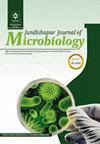骆驼蓬提取物对白色念珠菌生物膜及相关基因表达的影响
IF 0.5
4区 医学
Q4 MICROBIOLOGY
引用次数: 0
摘要
背景:由于常见的药物治疗不能根除念珠菌生物膜,因此需要进行广泛的研究来开发更有效的抗真菌化合物,并确定其对念珠菌生物膜的作用机制。骆驼蓬是一种传统药用植物,其种子已被用于治疗各种疾病。目的:本研究旨在探讨骆驼蓬提取物(PHE)的抗生物膜机制以及CAT1、EFG1和BCR1基因在白色念珠菌氧化应激反应和生物膜形成中的表达。方法:采用结晶紫法测定PHE对33株白色念珠菌的生物膜形成情况。最后,进行实时聚合酶链反应来分析PHE对白色念珠菌中CAT1、EFG1和BCR1基因表达的影响。结果:本研究确定了15个分离株的最小生物膜根除浓度(MBEC),其浓度在0.49-3.9μg/mL骆驼蓬提取物之间。统计分析表明,PHE暴露于白色念珠菌生物膜可显著降低白色念珠菌分离株中CAT1mRNA的表达(P=0.0068),但EFG1和BCR1基因的表达没有显著差异。结论:PHE能显著降低中药提取物处理的白色念珠菌细胞中CAT1的表达。PHE可能通过减少CAT1表达和破坏促氧化剂/抗氧化剂平衡来积累过氧化氢(H2O2),从而导致活性氧(ROS)的过量产生,并可能对细胞成分造成损伤,最终破坏白色念珠菌生物膜。本文章由计算机程序翻译,如有差异,请以英文原文为准。
Effect of Peganum harmala Extract on Biofilm and Involved Gene Expression in Biofilm Production of Candida albicans
Background: Since common drug therapies cannot eradicate Candida biofilm, extensive studies are required to develop more effective antifungal compounds and identify their mechanism of action against Candida biofilm. Peganum harmala L. is a traditional medicinal plant, the seeds of which have been used to treat various diseases. Objectives: This study aimed to investigate the anti-biofilm mechanisms of P. harmala extract (PHE) and the expression of CAT1, EFG1, and BCR1 genes involved in oxidative stress response and biofilm formation in Candida albicans. Methods: Anti-biofilm activity of PHE was evaluated by crystal violet assay to determine biofilm formation on 33 C. albicans isolates. Finally, a real-time polymerase chain reaction was performed to analyze the effect of PHE on the expression of CAT1, EFG1, and BCR1 genes in C. albicans. Results: This study determined the minimum biofilm eradication concentration (MBEC) of 15 isolates in concentrations between 0.49 - 3.9 μg/mL of P. harmala extract. Statistical analysis showed that the exposure of C. albicans biofilm to PHE significantly reduced the expression of CAT1 mRNA in C. albicans isolates (P = 0.0068). However, no significant difference was observed in the expression of EFG1 and BCR1 genes. Conclusions: The results demonstrated that PHE significantly decreased CAT1 expression in C. albicans cells treated with the herbal extract. PHE is likely to accumulate hydrogen peroxide (H2O2) by reducing CAT1 expression and disrupting the pro-oxidant/antioxidant balance that leads to the overproduction of reactive oxygen species (ROS) and can cause damage to cellular components and eventually destroy C. albicans biofilm.
求助全文
通过发布文献求助,成功后即可免费获取论文全文。
去求助
来源期刊

Jundishapur Journal of Microbiology
MICROBIOLOGY-
CiteScore
1.30
自引率
0.00%
发文量
56
审稿时长
6-12 weeks
期刊介绍:
Jundishapur Journal of Microbiology, (JJM) is the official scientific Monthly publication of Ahvaz Jundishapur University of Medical Sciences. JJM is dedicated to the publication of manuscripts on topics concerning all aspects of microbiology. The topics include medical, veterinary and environmental microbiology, molecular investigations and infectious diseases. Aspects of immunology and epidemiology of infectious diseases are also considered.
 求助内容:
求助内容: 应助结果提醒方式:
应助结果提醒方式:


